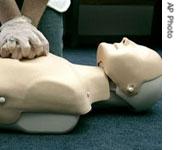-
(单词翻译:双击或拖选)
Health Report - How to Do 'Hands-Only CPR'
The American Heart Association simplifies its guidelines for lifesaving action when a person's heart stops. Transcript1 of radio broadcast:
06 May 2008
This is the VOA Special English Health Report.
 |
| Chest compressions on a CPR training dummy2 |
Cardiopulmonary resuscitation3, or CPR, is help for a stopped heart. It increases the chances of survival and reduces the danger of brain damage. With traditional CPR, you push hard on the chest thirty times, then stop to give two breaths to force air into the lungs. You repeat the steps until the victim can get medical treatment.
But people may worry about getting sick from blowing into a stranger's mouth. Also, the training is easy to forget, especially in a crisis. And those without training may be afraid to do anything for fear they will do something wrong.
So now, the American Heart Association has simplified its guidelines and is calling for hands-only CPR. Here is how it works.
A person has collapsed5 and is unconscious. The victim has lost color in the face and does not appear to be breathing. These are signs of cardiac arrest -- and this is the time to begin CPR.
Place your hands, one on top of the other, on the center of the chest. Push hard and fast. Aim for a rate of about one hundred presses in a minute. Chest compressions keep the blood flowing to the brain, heart and other organs.
CPR guidelines from two thousand five said only untrained people should use this method. Those with training were told to use traditional CPR. But now the American Heart Association says everyone should use hands-only CPR unless they feel strong about their ability to do rescue breathing.
The organization says the hands-only method was just as effective as traditional CPR in several studies. Scientists say there is enough oxygen remaining in a person’s system for several minutes after breathing stops. They also say people need less oxygen when the heart is at rest.
The American Heart Association recommends hands-only CPR for use on adults who suddenly collapse. It says traditional CPR with a combination of breaths and compressions should be used for babies and children. Traditional CPR should also be used for adults who are found already unconscious and not breathing normally. And it should be used for any victims of drowning or collapse from breathing problems.
These are all examples of cases where CPR with mouth-to-mouth breathing may be more helpful that hands-only CPR. The American Heart Association says because there are many such cases, people should still learn CPR that includes mouth-to-mouth.
And that’s the VOA Special English Health Report, written by Caty Weaver6. For a link to more on hands-only CPR, go to voaspecialenglish.com. I’m Mario Ritter.
 收听单词发音
收听单词发音
1
transcript

|
|
| n.抄本,誊本,副本,肄业证书 | |
参考例句: |
|
|
|
2
dummy

|
|
| n.假的东西;(哄婴儿的)橡皮奶头 | |
参考例句: |
|
|
|
3
resuscitation

|
|
| n.复活 | |
参考例句: |
|
|
|
4
collapse

|
|
| vi.累倒;昏倒;倒塌;塌陷 | |
参考例句: |
|
|
|
5
collapsed

|
|
| adj.倒塌的 | |
参考例句: |
|
|
|
6
weaver

|
|
| n.织布工;编织者 | |
参考例句: |
|
|
|















